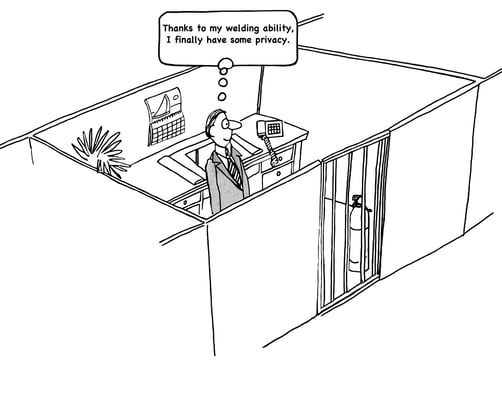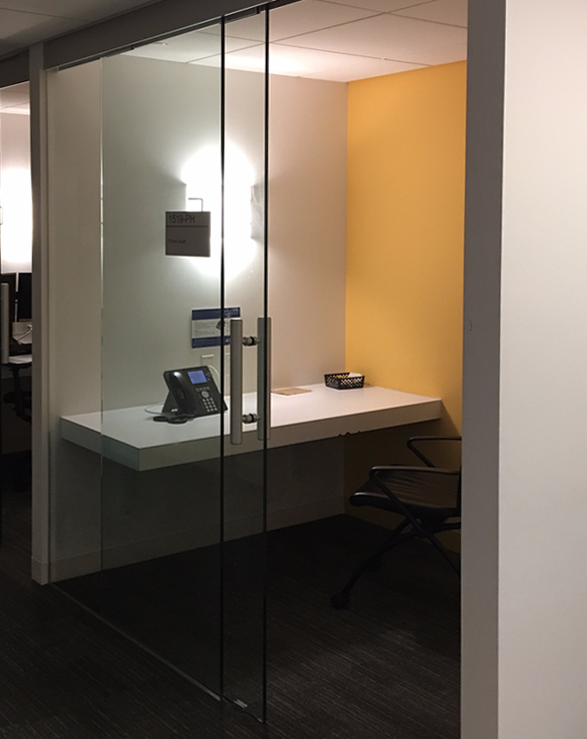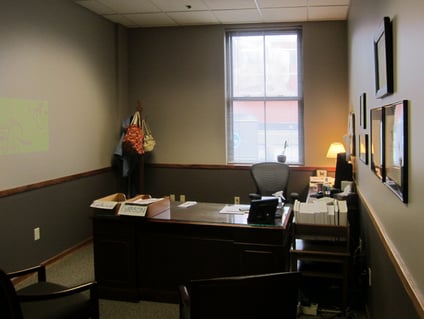Several years ago, I worked on a survey of employees for an organization, including a number of lawyers. Nearly unanimously, their replies indicated that they could not work in an open office because they required privacy for their jobs. That certainly seems reasonable. After all, there’s a lot of occupations, lawyers included, that require privacy or private spaces to function. Or so I thought, anyway, until I started working recently with a space transition team that helps organizations move from traditional offices into mobile and open office space with the goal of reducing the amount of space required per person. This experience has changed my opinion on this issue. I firmly believe that you can absolutely get privacy in an open office. Let’s talk about how.
The traditional office layout is designed to provide dedicated private spaces, both offices and high-walled cubicles, for each employee. In this type of layout, employees can invite others into their office or venture from it when they need to collaborate. By contrast, an open office flips the use of space by having employees conduct most of their work in an open environment and by providing private spaces for less frequent collaboration. The lack of dedicated space and a more flexible open environment can lead to a false impression that privacy is nonexistent (or difficult to find), which may be one of the reasons people resist transitioning to this type of layout. In an effective open office design, however, privacy is absolutely available to employees – when they need it.
Who Needs Privacy?

This is not as simple as separating employees into two groups – those who need privacy and those who do not. In reality, every employee requires privacy for focused work or private conversations at certain times. But when work styles and habits are analyzed, most employees do not need total privacy for the majority of their work day.
Employees who regularly work with sensitive information, such as human resources personnel, often assert that they require a higher level of privacy than employees in other professions. Based upon information gathered across the surveys I’ve assisted with and HR professionals I’ve spoken to, the reality for many of these job functions is that employees may only need a dedicated private space for as little as 20% of their work day. This means that rather than providing five dedicated, full-time offices for five employees, as an example, an open and mobile office can instead provide five workstations and two or three shared private spaces that can be scheduled and reserved. This leads to a much more efficient use of space.
In addition, the benefits of working in open spaces often outweigh the loss of dedicated private space for the HR employees that I’ve spoken to. While privacy is a concern, the HR professionals who have moved to an open office layout generally feel that working in a more collaborative space is extremely beneficial and supports the engagement they need to do their jobs. Employees who came to the office for HR support reported feeling less intrusive compared to the experience of having to knock on a closed office door or schedule an appointment. Put simply, breaking down walls can help build relationships.
Regardless of the type of job, employees in an open office may be uncomfortable making a private phone call, holding a sensitive conversation, or viewing confidential documents in the open, where they could be overheard or seen. But a properly designed open and mobile office would provide private space that can be used as needed for these types of activities by everyone in the office when needed.
Private Spaces in an Open Office
You may already have a sense of the private spaces that are needed but one of the benefits of an open office design is that there are many options for different space types based upon what an organization needs. Here’s some of the more common private spaces available in an open layout:
- Phone Booths – A phone booth is a small, enclosed space with a table or millwork desk that allows employees to sit down, close the door, and make a phone call or join a videoconference on their laptop in a quiet, comfortable space.

Phone Booth
- Private Offices for Reservation – A private office that can be reserved is exactly like an enclosed office in a traditional sense but the key difference is that it is shared using a reservation system. For example, if an HR employee knows she is going to be conducting interviews for the day, she could reserve a private office and conduct business comfortably for the entire day. As a side note, while there are many technologies available for electronic room reservation systems, these can also be as simple and cost-effective as a binder or piece of paper where individuals can sign up for their desired time slots.

Private Office for Reservation
- Closed Meeting Rooms – A closed meeting room is a space that can comfortably seat up to six people and that allows intimate and private meetings, but can also serve as an individual workspace if needed. They are also available for videoconferences with remote employees or external contacts.

Closed Meeting Room
- Conference Rooms – These are well known to most office workers – let’s face it, we’ve all suffered through meetings in them over the years – but their utility is extended in an open office. In a traditional office, if employees have dedicated cubicles or offices they might meet with two or three people in that space while the conference room sits unused except when a large group needs to meet. But in an open office, conference rooms fill in for this function and increase the overall utilization of your space, especially if all nearby closed meeting rooms are currently in use.

Conference Room
- Lockers – Though they may seem small or insubstantial, a locker is a fantastic way of maintaining a private and personal-feeling space in an open office. Lockers also provide a huge benefit in that the quite common “desk clutter” seen on workstations is hidden out of view in each person’s individual locker.

Lockers
Let’s Talk Specifics
Since I’ve mentioned the benefit of needing less space in an open office, let’s look at an example of how space transition can reduce the amount of square footage required in this type of layout. Three employees in 120-square foot private offices would require 360 total square feet of office space. But if those same three employees only need private space for about one-third of their typical work day, you could transform your office to a mobile/open office configuration, with three 64-square foot workstations, and two 36-square foot phone booths, reducing the total office space requirement to 264 square feet. That is about a 27% reduction in space for this small example! The economic benefit of shared space increases as you consider larger offices with larger quantities of shared spaces and more flexibility in the variety and diversity of employees’ schedules. In fact, the space and associated cost savings that accrue from removing unnecessary private space and increasing the amount of more flexible workspaces, can add up quickly. Surely your organization could find a more useful way to spend those savings.
After hearing the resistance from the lawyers who responded to the surveys I mentioned at the beginning of this blog, my team had the opportunity to subsequently tour several open office law firms and we found that they have actually adjusted quite well to the space transition! An HR employee I talked to after a move to an open office summed it up quite nicely:
I think it's an advantage to have HR in the public space. It feels less intrusive for other employees to stop in and get support vs. having to knock on an office door or schedule an appointment. In my opinion way better for collaboration, support, and engagement.
Back to the question in the blog title – You can Have an Open Office and Still Have Privacy: Fact or Fiction? The answer to this would be a resounding FACT!









.jpg)
.jpg)
-1.jpg)
.jpg)
.jpg)
.jpg)
.jpg)
.jpg)

